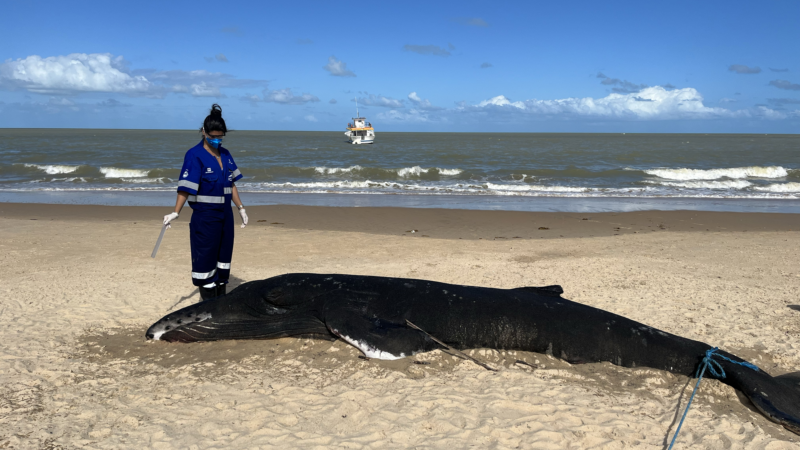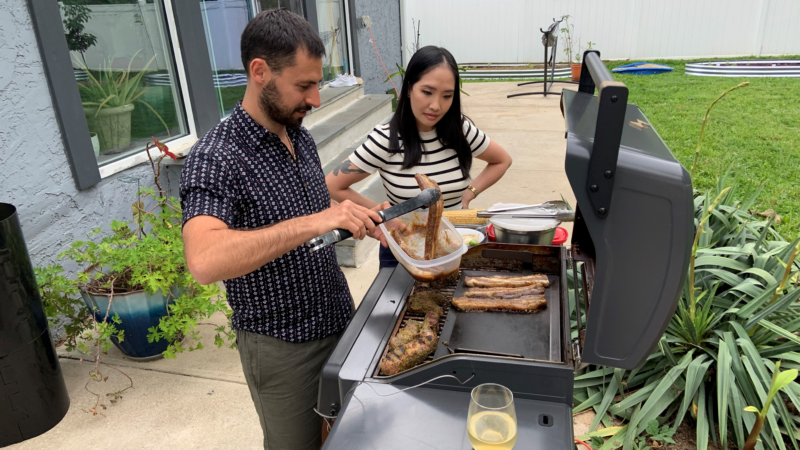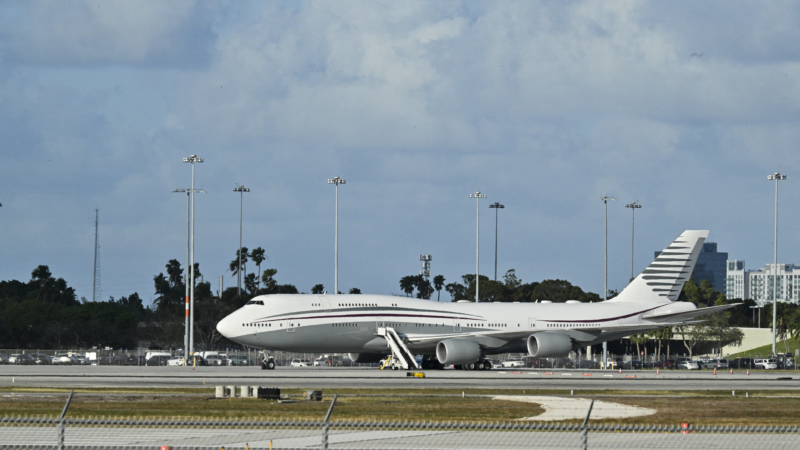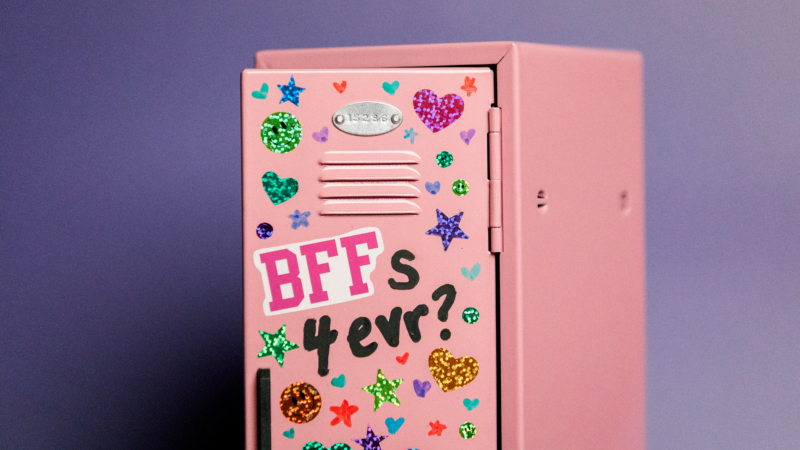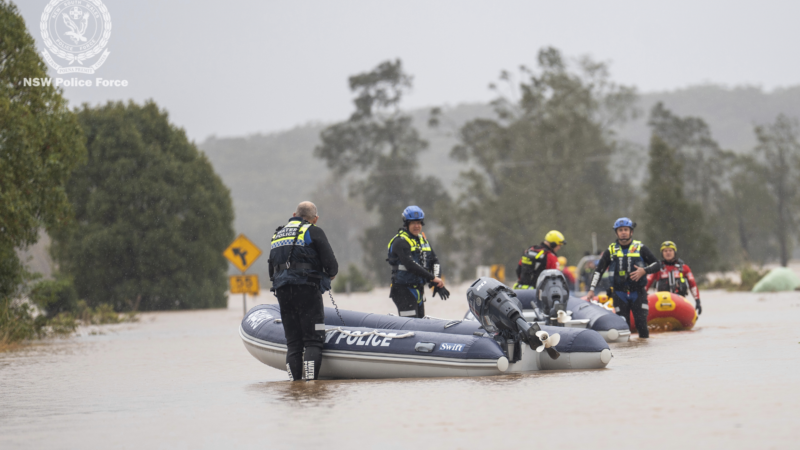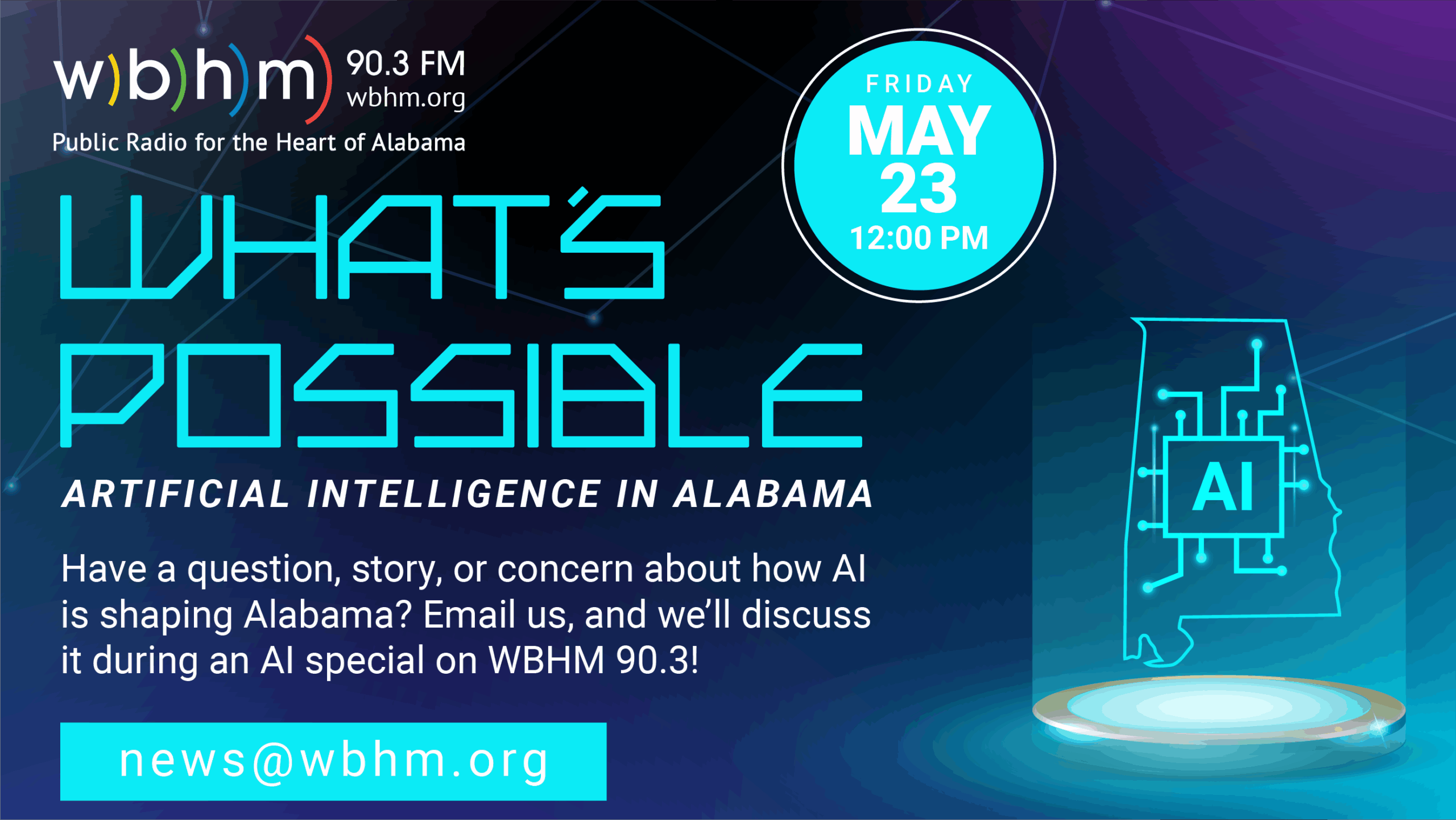‘Give me the head!’ Neuroscientist inspires whale and dolphin research in Brazil
A year and a half ago, neuroscientist Kamilla Souza got the call she’d been waiting for. A baby humpback whale was adrift just offshore, in the waters off southeastern Brazil. It had died — and she wanted its brain.
“It’s like Alice in Wonderland,” says Souza, the founder and scientific director of the Brazilian Neurobiodiversity Network. She riffs off the classic line “Give me the head!”
Souza has been fascinated by the brains of marine mammals ever since she was young. She says there’s very little known about the brains of whales and dolphins living in the waters off Central and South America. But studying them can teach scientists about the inner workings of these animals — about their behavior and how they’re adapted to living underwater.
By the time Souza and her colleagues from the Instituto Baleia Jubarte arrived on the scene by boat, the whale had washed ashore a tiny island — and they had a problem — they could only get so close without running aground.
“You look at the situation,” she recalls, “and you say, ‘OK, I need it. I’ll get this one no matter what.’ I didn’t have time to think. You just have to go.”
So Souza grabbed her scalpel and saw, and she swam to shore. Soaking wet, she got out her tools and managed to extract the fresh, intact brain from the recently deceased whale. She was elated.
“It was the first extraction of a whale brain here in Brazil,” she says proudly.

She then swam back to the boat with the brain nestled in a protective container.
Souza brought it back to her lab where it joined the ranks of what she says has become the largest collection of whale and dolphin brains in all of Latin America.

A race against time
Inside the necropsy room, a couple of veterinarians sharpen their knives to dissect another dolphin that recently stranded nearby. A parade of organs appears on the table to be measured and photographed — the heart, a kidney, the uterus.
Souza walks around to the head. “So here we have the skull,” she observes. But, she says, “there is no brain.” That’s because it’s basically liquefied.
The heat in this area of Brazil accelerates decomposition, so minutes matter. This is why sometimes, Souza has to extract the brain from a freshly deceased animal right on the beach. “We have to deal with people, animals, the weather,” she says with a laugh. “Sometimes it’s raining.”
Souza is relentless, says Daniela Teles, one of the Orca Institute veterinarians. “Kamilla can find the treasure that is hidden inside all of this flesh and carcass and smell,” she says. “She finds the brain and studies it. And it’s amazing.”

A fridge filled with brains
Souza opens up a normal-looking refrigerator in her office to show off a few of those treasures. She has a brain from a pygmy sperm whale, various dolphin species and more. She takes the lid off the largest plastic container to lift a hefty-looking brain out of the liquid preservative. It’s from that baby humpback she swam ashore to dissect and it’s twice the size of a human brain.
“So this brain is huge,” Souza says with admiration. “I need the two hands to hold this brain.”
There before her is, arguably, she says, the convoluted essence of a humpback whale — the thing that lets it swim and sing and so much more.
Given her international training, her access to understudied species, and all she’s accomplished, Souza says she’d likely be able to work abroad. “But I’m here because I want to be,” she says. “I want to do this kind of research here. My idea is to cover as much of the Brazilian coast as I can. I want to bring this knowledge to Brazil. I want to inspire Brazilian people to do something new, to do something special.”
One of those people is Heitor Mynssen, Souza’s Ph.D. student. He’s developing a computer tool to model a variety of cetacean brains in 3D. He, too, wants to contribute to the field from here. “We don’t have to always rely on other countries,” he says. “We can actually do it on our own, and show the world that we can actually do good science. Being able to be a scientist in Brazil, it feels like part of me.”
João Marcelo Ramos Nogueira, the executive director of the Orca Institute, is delighted to have Souza on his team. “Once Kamilla came in,” he says, “we had the possibility to expand the analysis and [do] more research.”
When Souza gets the chance to look out at the ocean and consider the trajectory that brought her to this moment, she says, “I think that I did the right thing because I’m super happy with my work and with the things that I’m doing for my country and for me as a researcher.”
Souza says she has no doubt that the child she used to be would be happy with where she ended up.
Transcript:
AILSA CHANG, HOST:
Picture this. You’re on a boat, racing to your island destination. You grab your tools and swim ashore, and you make it in time to extract the brain from the dead humpback whale before you. This is what happened to Brazilian neuroscientist Kamilla Souza a year and a half ago.
KAMILLA SOUZA: You look at the situation, and you say, OK, I need it. I’ll get this one, no matter what. You cannot think. You just have to go (laughter).
CHANG: Souza is fixated on finding whale and dolphin brains along the Brazilian coastline. Science reporter Ari Daniel visited her to understand why.
(SOUNDBITE OF VAN DOOR OPENING)
ARI DANIEL, BYLINE: So there’s a van that just arrived with a special delivery?
SOUZA: (Laughter) I would say yes. It’s a dolphin that’s stranded in a beach.
DANIEL: This is Kamilla Souza. She’s bedecked in marine mammal jewelry.
SOUZA: ‘Cause people know that I like dolphins (laughter).
DANIEL: And until recently, before taking time off for a short fellowship at Oxford, she was the scientific director here at the Orca Institute, a conservation organization in Vitoria in southeastern Brazil. They tend to any marine mammal that strands along their section of the coast and either rehabilitate and return it to the water if it’s alive…
(SOUNDBITE OF CHAINS WINDING)
DANIEL: …Or, as is the case with this deceased Guiana dolphin being hoisted into the air, bring it back to their facility.
SOUZA: We are going to analyze all the organs of this animal and to investigate the cause of the death.
DANIEL: With an eye towards preventing similar deaths in the future, often due to entanglement with fishing gear or loud underwater noises that cause the animals to surface too quickly – but ever since she was a little girl, Souza’s had her eye on a particular part of an animal like this one.
SOUZA: I think about the brain (laughter).
DANIEL: You think about the brain?
SOUZA: It’s like “Alice In Wonderland.” Give me the head (laughter).
DANIEL: Souza says there’s very little known about the brains of whales and dolphins living in the waters off Central and South America. Mapping how those brains are wired up can teach scientists about the behavior and adaptations of these animals. In addition…
SOUZA: Dolphins have Alzheimer’s, encephalitis, meningitis, so it’s an opportunity to understand diseases that can also affect humans.
DANIEL: For all these reasons, Souza’s intent on studying cetacean brains from this part of the world, and she’s making real progress. She points to the suspended Guiana dolphin, a species whose behavior is well described.
SOUZA: But studies about the brain, we didn’t have, so we published the first brain description for this species.
DANIEL: Souza and her colleagues used an MRI to describe the neuroanatomy of a Guiana dolphin that washed ashore west of Rio, which was a real achievement for reasons that soon become clear. Souza takes me to the necropsy room.
(SOUNDBITE OF KNIVES SHARPENING)
DANIEL: The vets sharpen their knives to dissect another dolphin, a female that recently stranded. Souza brings me around to the head.
SOUZA: So here we have the skull. There is no brain.
DANIEL: OK, it’s liquefied.
SOUZA: Yeah, exactly. And that’s the point. We need to have a fresh carcass.
DANIEL: And that’s a challenge in a big country like Brazil. The heat accelerates decomposition. Minutes matter, which means sometimes Souza has to extract the brain from an animal right on the beach.
SOUZA: We have to deal with people, animals (laughter), the weather.
DANIEL: But Souza’s relentless, and whenever the conditions do conspire in her favor, she gets another brain.
(SOUNDBITE OF FOOTSTEPS)
DANIEL: I follow her next door to her office.
This is definitely a refrigerator filled with brains.
SOUZA: It’s the largest collection of cetacean brains from Latin America.
DANIEL: In this fridge alone, she’s got a brain from a pygmy sperm whale, various dolphin species and more. She lifts a brain out of the largest plastic container. It’s from that baby humpback she swam ashore to dissect, and it’s twice the size of a human brain.
SOUZA: So this brain is huge. I need the two hands to hold this brain.
DANIEL: Wow.
There before me is arguably the convoluted essence of a humpback whale, the thing that lets it swim and sing and so much more.
SOUZA: It was the first extraction of a whale brain here in Brazil.
DANIEL: Given all she’s accomplished, Souza says she’d be a plum pick to be hired abroad.
SOUZA: But I want to do this kind of research here. I want to inspire Brazilian people to do something new, to do something special.
DANIEL: People like her Ph.D. student Heitor Mynssen, who’s developing a fancy tool to model the cetacean brain in 3D.
HEITOR MYNSSEN: We don’t have to always rely on other countries. We can actually do it on our own and show the world that we can actually do good science.
(SOUNDBITE OF WAVES CRASHING)
DANIEL: My last stop is a nearby stretch of beach. Souza looks out at the ocean and considers the trajectory that brought her to this moment.
SOUZA: I think that I did the right thing because I’m super happy with my work and with the things that I’m doing for my country and for me as a researcher.
DANIEL: Souza says that little girl she used to be would be happy. For NPR News, I’m Ari Daniel.
(SOUNDBITE OF MUSIC)
Electric grills are a climate-friendly option to fossil fuel grills
Grilling usually involves burning fossil fuel. But some manufacturers are offering electric grills and citing climate change and convenience as reasons to switch.
Graphics: Here’s what it will take to transform the Qatari jet into Air Force One
The U.S. has officially accepted a luxury jetliner from Qatar as a gift, and slated it to become a new Air Force One. Experts say that overhaul could take years and cost hundreds of millions.
Kristi Noem couldn’t define habeas corpus. Can you? Find out in the quiz!
Tush pushes, prison breaks, luxury jets and orange cats: This week's quiz is the usual potpourri of the silly and sublime. Actually, not the latter.
NPR wants to hear from interracial couples to commemorate Loving Day
Loving Day, the landmark case that overturned U.S. state laws against interracial marriage, is on June 12. NPR wants to hear from people who celebrate this day.
Why you should fight to keep old friends
Nina Badzin, host of a friendship podcast, explains why staying friends with people from our past matters — and how to nurture relationships with old friends across time and distance.
Record floodwaters in eastern Australia leave 4 dead and 1 missing
Some 50,000 people have been isolated by the flooding in New South Wales, after days of heavy rain. Four bodies have been retrieved from floodwaters since Wednesday.

